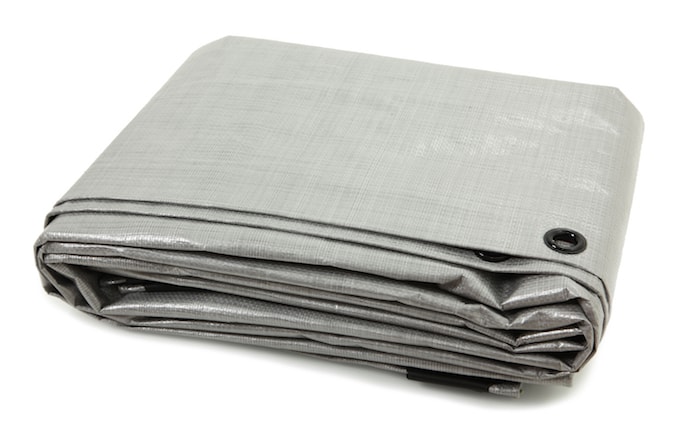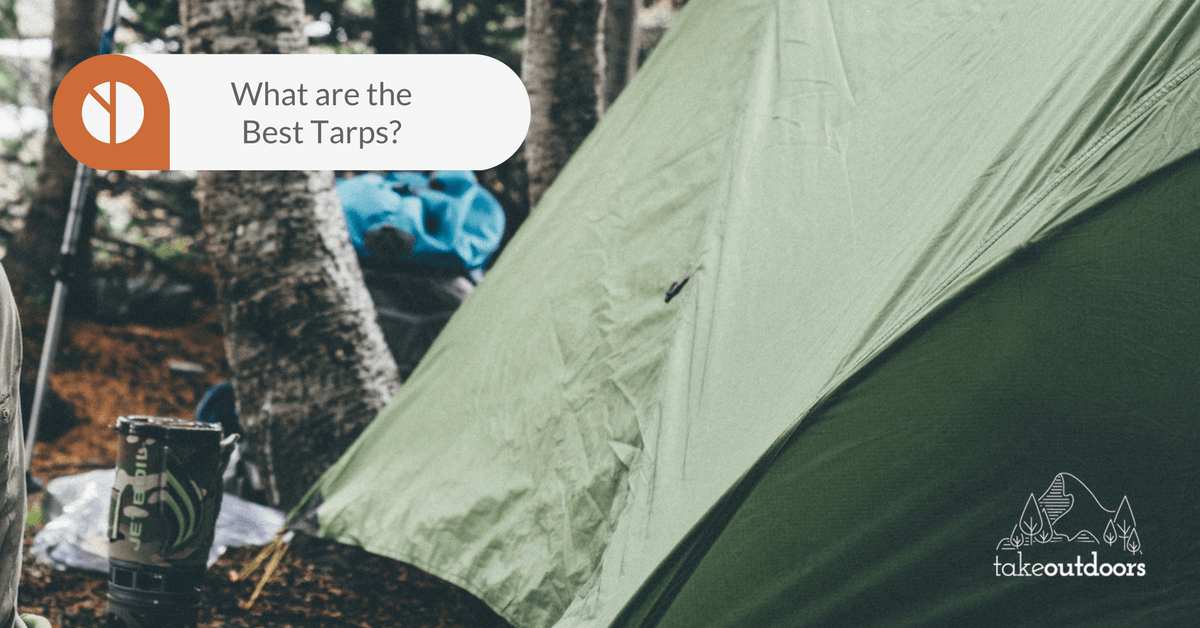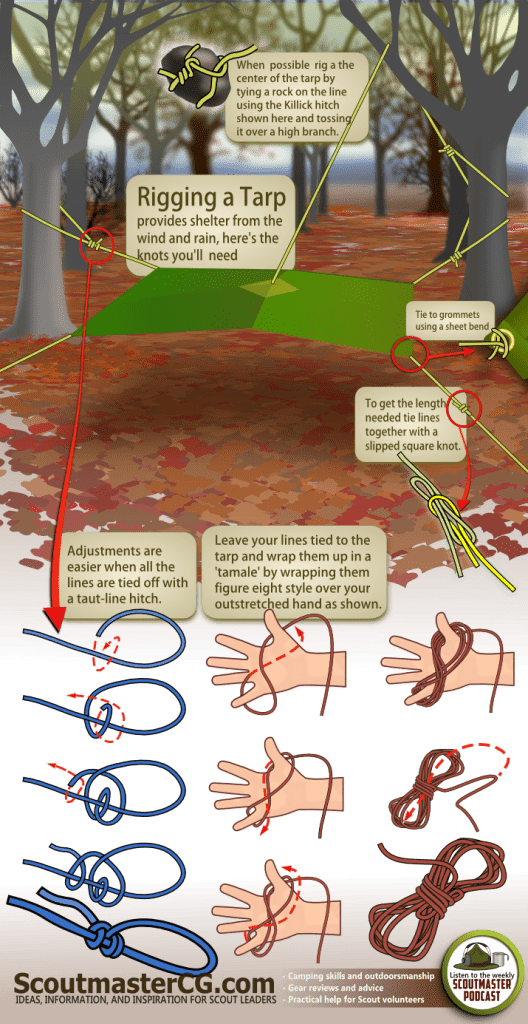We use affiliate links and may receive a small commission on purchases.
Read more about us.
In this article, we will be looking at the best tarps for camping. And if you want to make a decision right now, we’d say go ahead and buy the Go Outfitters Apex Camping Shelter/Hammock Tarp for its well-rounded features.
Quick Introduction
What’s a tarp? It’s a sheet. It’s a powerful sheet. It’s the protector of everything including you. This is how it looks like:

There are many uses for a tarp. Woodcutters use it to cover their logs. Water rafters (if there is such a word) attach it to their raft and sail. RVers protect their roof with a tarp from water damage. And plenty more.
But for camping, here are the common uses:
- You can put a tarp underneath your tent if you find the floor too thin. This would also protect your tent floor from abrasions.
- Need a quick shelter for sleeping, you can set up a tarp tent and sleep in a bivy. Or, set up a hammock and put up a tarp for shelter.
- Use a tarp to cover your firewood and protect it from getting wet.
- It can act as an emergency blanket to trap body heat if anyone is suffering from hypothermia.
- Because it is so durable, you can also make a sack out of it and carry your goods.
- Tarp can be used for fun too! Turn it into a slide, pour water and make it wet, then let your kids go crazy.
And for this article, we will focus on getting the right type of tarp with a good coverage and durability.
Best Tarps for Camping Buying Guide
Materials
Tarps come in many types of materials. The common types for camping are Silnylon, Cuben Fiber, Poly and Tyvek.
Silnylon
Silnylon seems to be the most popular material for tarps. The material is very waterproof and lightweight which makes it a good choice for ultralight backpacking. However, it is not breathable and it stretches when wet. You have to keep tightening it periodically so that it won’t sag too much.
Cuben Fiber
Cuben Fiber is lighter than Silnylon but more costly than Silnylon. It does not stretch when wet and is theoretically 100% waterproof. It doesn’t take up much space. However, this material is prone to abrasion.
Poly
Poly tarps are cheaper than Silnylon. It does not stretch when it is wet also. However, they are heavier and use up more space than Silnylon. This might not be a good choice for ultralight backpacking.
Tyrek
Tyvek comes in different versions. Each serves a different purpose. The main characteristic of Tyvek is that they are lightweight, water resistant yet breathable. They are cheap as well but they tend to take up more space and usually ugly.
Backpackers on a lower budget would like to use Tyvek to make their gear like stuff sacks and tarps. If you want to find out what kind of Tyvek to get, there is an article on this.
Shape and Size
The size and shape of the tarp depend on what you are providing a cover for. If you are setting up a tarp tent, you need to decide what shelter configuration you are going for. There are choices like the A-Frame, Half Pyramid, Flying Diamond, etc.
Each configuration has a different requirement for the number of guy lines, stakes and tree branch or trekking poles. Each of the different configurations has its own advantages and disadvantages.
After that, you can decide how many people are going to stay under that shelter. Place your bivy or whichever sleeping equipment underneath the shelter to mark the area that you need to cover. Then, start pitching the tarp.
Having a big tarp can add unnecessary weight to your backpack. For protecting the base of your tent, measure your tent floor dimensions and find the next available size that is a little bigger than your tent floor. Also, take note of the shape of the tent floor so you won’t end up getting a square tarp for a rectangular floor.
If you are using the tarp as a shelter for your hammock, there is a guide on getting the right size and shape for sheltering your hammock.
Thickness
If a thin tarp can repel the water away, you can carry on using that. There is no need to get a thicker one. Having more thickness in the tarp adds more weight but may not provide any additional water resistance.
However, if you are using the tarp to protect your tent floor, you probably want to get a thicker one to increase its tear resistance for better protection.
Construction
Check out how the grommets and tie-outs are being installed on the tarp. When the tarp is set up, the area around the grommets and tie-outs will be handling a lot of stress because of the pulling. Check if the area is reinforced with another layer of fabric to distribute the stress.
Tie-outs are preferred for staking out as it will distribute the stress over a larger area uniformly compared to grommets.
Check out how the seams are being sealed. If the seams around the reinforcement are not well stitched or there are too little stitches, the reinforcements might tear when there is a tension on the grommets.
Tarps can also come in different styles. There are flat tarps and shaped tarps.
Flat tarps are simple squarish or rectangular tarps. Because of its flexibility, they can be set up in a wide range of shapes depending on the environment. However, they can be heavier because they use more fabric.
Shaped tarps are not squarish or rectangular. They tend to have catenary cuts which make the edges curved. These cuts reduce noise by preventing flapping. They also make the rain run off the fabric smoothly which reduces sagging.
They also have different positioning of the tie-outs and grommets. Because of this, it is less flexible than flat tarps. You have to pitch them in a certain way which are optimized for specific environments.
Colors
If you were someone who looks at the overall aesthetics of your camping area, you might be picky about finding the right color. This is to make sure the rest of your gear matches well with the tarp.
But there are practical advantages. If you are a wildlife photographer, you might want to get a forest shade green tarp to camouflage yourself while taking shots at the animals. However, this also makes it harder for you to spot your shelter when you come back from somewhere.
You can get a tarp with bright colors to easily spot your shelter. Bright colors also help in slowing down UV degradation because they reflect sunlight rather than absorbing it.
Setting up
Setting up a shelter using the tarp requires you to know a couple of knots. Tarps come with either grommets or tie-outs to tie a knot and connect your rope to a pillar. After tying your knots, the tarp should be stretched. It shouldn’t be sagging if not it will start collecting water.
Equinox Egret Tarps
Our Rating:

![]()
The key seams are double stitched but some users reported that the center area has single stitches only. Because of this, there are cases of water leaking through the seam when there is rain. You probably want to seal the seam first before bringing it out.
Because of the material it uses, this tarp is quiet even when there is the wind. You can sleep comfortably while feeling the breeze.
There is only one color to choose for this tarp. The color is leaf green which can blend well in the forest. But if you fancy other colors, then this one is not for you.
This product comes in various sizes. Unless you are getting the bigger sizes, the weight is considered light for backpacking. If you are looking for a lightweight and sturdy tarp, you can go for this one.
- Grommets are reinforced
- Quiet tarp
- Lightweight
- Only one color to choose from
- May have water leaking through the single stitched seams
Go Outfitters Apex Camping Shelter/Hammock Tarp
Our Rating:

![]()
It has 20 tie-out loops which make it very configurable. The tie-outs are reinforced with a large triangular piece of fabric. This adds extra support to the tie-outs and prevents them from ripping off easily. However, this also adds extra weight.
There are a couple of colors to choose from. You can mix and match the color of the tarp to the rest of your gear.
It has catenary cuts which make it quiet during a windy situation and doesn’t sag when the rain comes.
The tarp comes with guy lines, tensioners, stakes and a stuff sack. These extra items are nice to have but some users reported that they are not made of good quality materials. You might be better off having your own set of guy lines, tensions and stakes.
This seems like a great to buy to a lot of people. It is not the lightest and cheapest tarp but it comes with plenty features that make it a multi-function product yet a configurable one. The size is also just right for most use cases. If you are okay with the price and weight, this would be the one to go for.
- Generous amount of tie-out loops
- Catenary cuts to prevent sagging from rain
- Different color to choose from
- Good enough size
- Not the lightest option
- Guy lines, tensioners and stakes may not be good enough
Ultimate Survival Technologies BASE Tube Tarp 1.0
Our Rating:

![]()
One side of the tarp is bright orange. This makes it easier to spot. The other side is made of reflective material. This makes it even easier to spot when it reflects light.
The reflective material also makes it a good emergency blanket as it reflects thermal radiation as well. If you want to keep yourself warm, you can just flip the tarp to face towards you so you can retain your body heat.
You might want to seam seal the tarp before you bring it out by the way. Some people reported that it is not exactly waterproof. There is still water leaking through the seams when there is rain.
This is a versatile shelter that can double up as an emergency blanket, providing heat in a cold weather. It adds other features which are useful in an emergency situation. If you are out for wilderness survival, this is one reliable tarp to go for.
- Can be easily converted into a tarp tent
- Has reflective material on one side for easy visibility
- Can be used as an emergency blanket
- Some users reported that it is not entirely waterproof
Aqua Quest Defender Tarp
Our Rating:

![]()
It is also made with thick heavy duty material which is able to stand up to strong wind, heavy rain. However, because of the materials it uses, the tarp is also heavy.
The colors that come with it are camouflage colors. This is useful for hiding yourself in the wilderness. If you are a wildlife photographer, this will be a good feature as it shelters you from harsh elements yet keeps you unnoticeable from the animals.
The tarp does not come cheap. But I think it is worth the price for its size and durability. It wouldn’t be a good choice for backpackers as it is heavy. If you are doing car camping, this is one tough tarp to go for.
- Large size
- Thick material
- Generous amount of tie-out loops
- Durable
- Not cheap
- Heavy
Geertop 1-4 Person Ultralight Waterproof Tent Tarp
Our Rating:

![]()
If you are looking to use it as a shelter, you might want to get a bigger one to cover more area. There are only 4 tie-out loops. You will only be able to do a simple roof shelter out of it.
I think the price is really good for the larger sizes. It serves its purpose well for protecting the tent floor from abrasions. It’s also a good choice as a picnic mat. However, I wouldn’t recommend using it as a canopy to protect yourself from the rain. You won’t be able to stay dry in a torrential rain.
If you are looking for a tarp to protect your tent floor, use it as a picnic mat or cover your gear at the back of a car, I would recommend going for this one.
Conclusion
After looking through the list of tarps again, I’m going to pick Go Outfitters Apex Camping Shelter/Hammock Tarp.
The size, weight, and versatility were the ones that influenced me to make this decision. This tarp has a good size, is lightweight and made to adapt to different camping environments. I would also say it is a safe buy as many people were pleased with their purchase.



